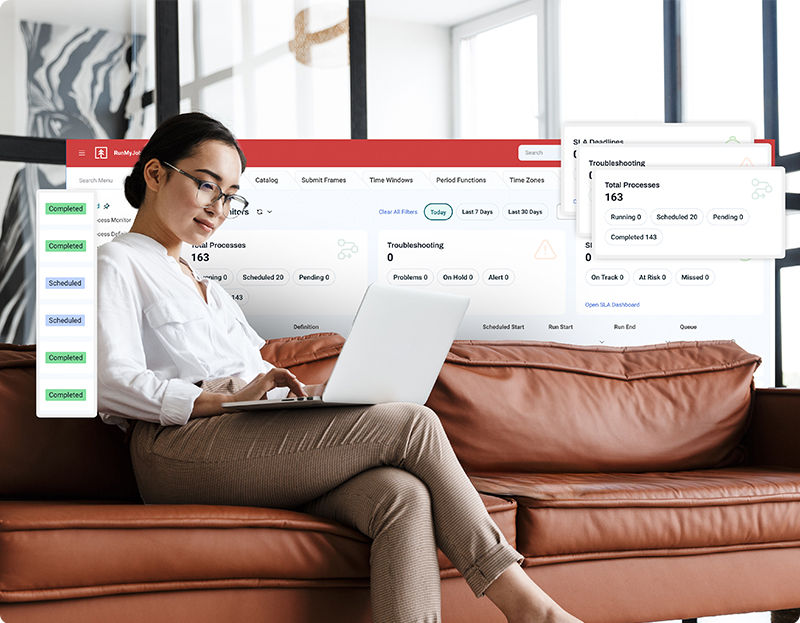Robust IT automation software
Automate and monitor any IT or business process with RunMyJobs by Redwood — a unified, cloud-native platform.

Eliminate time-consuming, manual processes
Extend the power of your IT team and achieve maximum operational efficiency by implementing seamless automated processes across your IT environment.
-
Low-code IT automation
Speed up automation creation with a drag-and-drop visual editor and an extensive library of convenient templates and helpful wizards.
-
Resilient, cloud-native scalability
Support your business initiatives today and plan for future advancements with a platform built to help modern enterprises grow efficiently.
-
SaaS-first architecture
Take advantage of a platform engineered for modern SaaS delivery, with lightweight agents and integrated dev, testing and production environments.
-
Comprehensive system control
Deploy a featherweight agent for CLI and use integrated scripting for greater control over UNIX, Linux, Windows and more.
-
Automated service delivery
Set up turn-key IT services via a bi-directional ServiceNow integration and automate dependencies to improve the end-user experience.
-
Strong automation strategy support
Discover the benefits of IT automation: Run millions of transactions daily to free up your IT staff for more strategic and innovative projects.

Boost productivity with cross-platform coordination
Redwood makes it easy to manage automated workflows and dependencies across any on-premises, multi-cloud or containerized IT environment. Automate repetitive tasks and reduce manual intervention with Redwood’s reusable process steps, sequences, calendars and more.
- Execute routine tasks in real time based on detected source files, data, events or messages from apps.
- Seamlessly coordinate and integrate legacy systems, disparate operating systems, open-source apps and cloud services using pre-built connectors and API adapters.
- Streamline DevOps with consumable workflow automation services and microservices with native SOA APIs and formats.
- Simplify processes across ERP, CRM, finance, data centers, business process management tools and artificial intelligence platforms.

Experience the ease of cloud-native SaaS
Redwood offers the only workload automation (WLA) solution purpose-built for SaaS delivery from the start. Eliminate the hassle of hosting, deploying and maintaining your automation platform. Easily connect to major cloud providers (AWS, Azure, GCP).
- Enjoy single-tenant cloud architecture with zero-effort maintenance and guaranteed 99.95% uptime.
- Easily set flexible load balancing and process priorities across applications to provide reliable, efficient IT services.
- Control servers and run scripts with lightweight, self-updating agents for Windows, Linux, AIX, HPUX, macOS, OpenVMS and Solaris.
- Access real-time metrics dashboards with alerts and SLA notifications to resolve issues before they impact performance.

Build a secure, simple IT infrastructure
- Access SAP, Oracle, AS/400, VMS and other applications and web services directly through TLS 1.3 encrypted, agentless connections.
- Use built-in authentication or SSO/SAML 2.0+ integration such as Okta, Ping Identity, PingFederate or Microsoft Azure AD.
- Establish a comprehensive audit trail for all process and user activity and enforce business rules across hybrid cloud.
- Rely on Redwood’s ISO 27001, SOC 2 and CSA STAR Level 1 certifications, best-in-class SaaS security policies and regular penetration tests.

Achieve true digital transformation
Redwood is designed to expand as business operations adapt to new challenges and require new technologies. All capabilities and connectors are included with simple, pay-for-what-you-use pricing plans.
- Add as many servers, environments and digital technologies as you need without restrictions or extra costs.
- Automate any use case using a low-code, drag-and-drop user interface with built-in wizards and reusable templates.
- Empower business users to confirm, request and interact with intelligent automation through self-service web forms and email processing.
- Gain new features and deploy security patches through patch management and automatic optimization updates that complete in minutes.
IT automation FAQs
What does IT automation mean?
Automation in IT refers to the use of software to manage applications or IT tasks without human intervention. IT professionals can set up automated tasks to be triggered by IT or business events, or tasks can be scheduled to run at specific times.
IT automation is related to business process automation (BPA) but focuses on IT processes, data and infrastructure automation. It is a deeper level of automation than robotic process automation (RPA), which focuses on rule-based tasks and mimics human interactions. IT process automation can automate complex, mission-critical workflows.
Modern workload automation technologies such as RunMyJobs by Redwood are considered cloud-native IT automation solutions. Learn how Redwood can help your organization with IT automation software.
What are the different types of IT automation?
The different types of IT automation include:
- Automated IT operations: Server provisioning and monitoring
- Automated software testing: Testing code changes and software functionality and catching bugs
- Business process automation: Invoicing and payroll
- Data management automation: Data backups and archiving
- Network automation: Configuration management and networking device monitoring
- Reporting and data analytics: Compiling performance data from IT automation tools
See how to manage your data warehouse with data management automation with Redwood.
What is the difference between IT automation and IT orchestration?
IT automation and IT orchestration are related concepts in the field of IT management, but they refer to different things.
IT automation focuses on automating individual manual tasks, while IT orchestration focuses on coordinating and managing multiple IT systems and processes to achieve a specific goal. IT departments can apply IT automation techniques to achieve complete orchestration, but it goes beyond just automation to include the coordination and management of multiple automated systems and processes. Learn about end-to-end business process orchestration with Redwood.